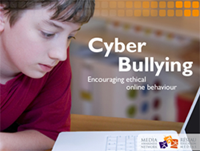Today is Safer Internet Day, an annual international event sponsored by Insafe to promote a safer Internet for children. Recent research on Internet life has shown that the greatest threat to kids online comes from kids themselves, both in the form of risky behaviour and online harassment, or cyber bullying. Cyber bullying can take forms such as harassing e-mails or text messages, social exclusion and spreading private photos and videos, among others, and presents a particular challenge for parents and teachers because it often happens outside the home or classroom. Because the Internet has become an essential part of kids' social lives, cyber bullying can also have more devastating effects as youth feel they have no es cape.
cape.
To help educators address this issue in their classrooms, Media Awareness Network, with the support of the Canada Gazette, has developed the bilingual lesson series Cyber Bullying: Encouraging ethical online behaviour. The resource give students a better understanding of the ethical and legal implications of cyber bullying, while promoting positive and ethical Internet use.
Intended to support and enhance school-based anti-bullying and empathy-building programs, Cyber Bullying: Encouraging ethical online behaviour comprises the following lessons:
Introduction to Cyber Bullying: Avatars and Identity
Grades 5-6
With the layering of identity through the use of nicknames and avatars, as well as a sense of anonymity, it is easy for young people to sometimes forget that real people—with real feelings—are at the heart of online conversations. In this lesson, students are provided with opportunities to explore this concept and discuss the importance of using empathy and common sense when talking to others online.
Understanding Cyber Bullying - Virtual vs. Physical Worlds
Grades 7-8
In this lesson, students explore the concept of cyber bullying and learn how the attributes associated with online communication may fuel inappropriate or bullying behaviour. Connections between other contributing factors to bullying—online and offline—are also reinforced as students develop an understanding of the role played by bystanders and the ways in which our own responses may fuel or stop this kind of behaviour. As a class, students establish a class “code of (N)ethics” for online conduct.
Cyber Bullying and the Law
Grades 7-8 and Grades 9-12 (two lessons)
In these lessons, secondary and middle school students learn about and discuss the legal aspects of cyber bullying. They review a variety of hypothetical scenarios and a case study, and consider the seriousness of the situations, who is legally responsible, what action (if any) should be taken and by whom. To determine this, students will seek answers to the following questions: How does cyber bullying differ from offline bullying? What aspects of a cyber bullying case make it a cause for legal action? What determines whether it is a civil or a criminal matter? How should rights to freedom of expression, guaranteed under the Canadian Charter of Rights and Freedoms, be balanced against rights to security of person? When and how are schools responsible for cyber bullying cases?
Cyber Bullying and Civic Participation
Grades 7-8
This lesson allows students to explore the concept of civic participation in the creation of Canadian laws through a study of the consultation process found in the Canada Gazette. Students will create their own School Gazette by proposing and discussing rules against cyber bullying at school.
Promoting Ethical Online Behaviour: Our Values and Ethics
Grades 7-9
In this 3-part lesson, students learn about online privacy and ethical behaviour by exploring their digital footprints to better understand how our online interactions may not be as anonymous as we think they are. In Part One, students create a digital map of their Web-based activities and the various characters and personas they assume online. In Part Two, students further assess the privacy and ethics of their online activities by applying their cyber-portraits to a questionnaire and, in Part Three, students look at areas in their virtual lives where they can make improvements.
